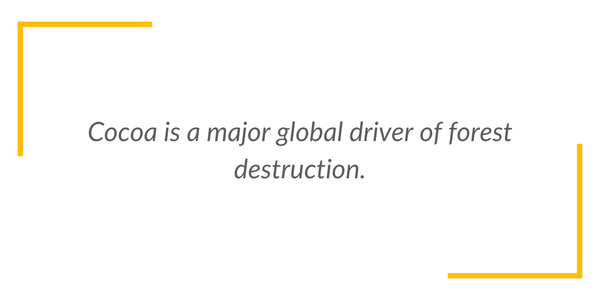
In The Fight Against Climate Change, Chocolate Has A Lot To Answer For
To state the obvious, we humans love chocolate. Our love seems to grow by the year - it’s predicted that the cocoa and chocolate market will grow with a compound annual growth rate of 4.6% between 2021 and 2030.*
However, the not-so-sweet truth is that to create space for new cocoa farms, the chocolate industry is fueling deforestation at an alarming rate, hitting the accelerator on climate change, destroying native habitats, and leaving a bitter taste in our mouths.
According to the United Nations, deforestation contributes to about 10% of human-induced greenhouse gas emissions.** Cocoa is a significant contributor.

West Africa produces three-quarters of the world’s cocoa, with Côte d’Ivoire and Ghana being the largest producers. These two countries have lost most of their forest cover in the past sixty years - around 94% and 80%, respectively, with approximately one-third of forest-loss to cocoa-growing. In 2018, these two countries also had the highest rise in primary forest loss of any tropical country. In 2020, another 47,000 ha of forest was lost in cocoa-growing areas of Côte d'Ivoire.
Forests are a critical natural resource in the fight against global warming as they both absorb and store carbon. When forests are destroyed the carbon that was stored within the forest is released into the atmosphere.

We’re not suggesting you need to breakup with chocolate (we couldn’t if we tried). But with today’s technology there are better ways to make chocolate while meeting increasing consumer demand.
Innovation + Collaboration + Legislation = a greener, sweeter future
The good news is that in the past 15 years we’ve seen some positive steps in the right direction.
2010 - Satellite Monitoring Is Introduced
This technology grants companies greater visibility of cocoa farming locations, making it easier to source from verified deforestation-free zones. We’re glad to see many companies starting to use this technology. After all, if they can’t see the issues, they can’t address them. New technologies are in development all the time.
2017 - The Cocoa and Forests Initiative (CFI) Is Established
CFI is a collaborative commitment to end deforestation and restore forest areas. Promisingly, it has received a warm embrace with the governments of Côte d’Ivoire and Ghana, as well as companies representing 85% of cocoa usage committed to the initiative.
We also noted in our most recent chocolate scorecard survey that deforestation-free, public grievance, noncompliance and Net-Zero policies are becoming more and more the norm within companies, showing that the industry is taking this issue more seriously.
2023 - EU Leads The Way With New Legislation
This legislation will ban the sale of agricultural products linked to deforestation in EU markets.***
What We’d Like To See More Of From Companies
- Better use of technology - While many companies have started to use satellite monitoring, it seems the technology is not yet used to its full potential. We’d like to see more deforestation forecasting to identify areas at risk of deforestation, as well as real-time monitoring which notifies companies to any changes in forest coverage. New technologies are in development all the time.
- Specifics - To have general policy is not enough. Companies need to create specific, time-bound goals for working with suppliers to map the origins of their cocoa.
- Transparency - We ask companies to publicly share not only their deforestation and climate mitigation policies but also the action steps they are taking to protect our planet.
I am but one individual chocolate lover. What can I do to help?
It’s not all bitter, we’ve found a number of companies leading the way, and more and more are joining the ranks. What makes companies really pause and pay attention is data and their bottom line. With that in mind, the best way to create positive change is to get out and eat some chocolate! We can think of worse ways to be an activist.
Click here to explore the top-ranked brands in the Deforestation & Climate Change category.
Author
Dr Stephanie Perkiss, Senior Lecturer in Accounting at the University of Wollongong, co-written by Athina Greenhalgh. Used with permission from Be Slavery Free.
References
*Polaris Market Research, 2022, Cocoa and Chocolate Market Share, Size, Trends, Industry Analysis Report, By Chocolate Type (Dark, Milk, White, and Filled); By Cocoa Ingredients; By Application; By Distribution Channel; By Region; Segment Forecast, 2022 - 2030, https://www.polarismarketresearch.com/industry-analysis/cocoa-and-chocolate-market
**United Nations, Land - the planet’s carbon sink, https://www.un.org/en/climatechange/science/climate-issues/land
***Mighty Earth, 2022, Mighty Earth welcomes landmark agreement on new European law to ban deforestation, https://www.mightyearth.org/mighty-earth-welcomes-landmark-agreement-on-new-european-law-to-ban-deforestation
Just like chocolate, this blog is better shared.
